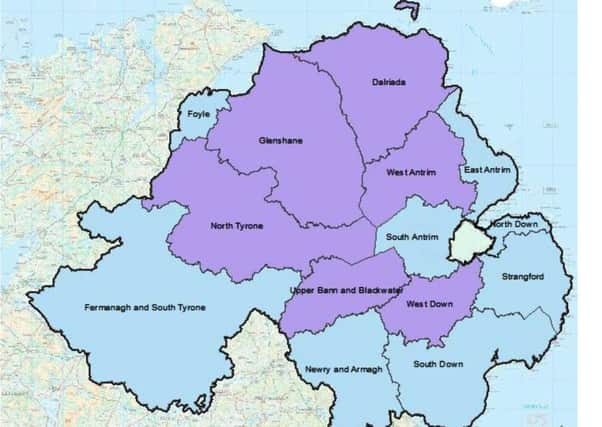Boundary changes: How will East Antrim be affected?


Last week, plans to redraw the boundaries of the province’s 18 parliamentary constituencies were revealed.
The report, compiled by the Boundary Commission, outlined a potential reduction of electoral areas from 18 to 17.
Advertisement
Hide AdAdvertisement
Hide AdIt is expected the new constituencies, which would apply during both Westminster and Assembly elections, will be in place by 2020.
The reason behind the changes is to try and equalise the number of voters in each constituency, according to the Commission.
Feedback on the new-look map is being encouraged from both political parties and members of the public.
The redrawn boundary lines would see East Antrim shift slightly ‘southwards’ to take in the current Belfast North wards of Whitehouse, Rathcoole, O’Neill, Carnmoney Hill, Glebe and Glengormley, along with the Jordanstown ward from South Antrim.
Advertisement
Hide AdAdvertisement
Hide AdAt the same time, the northern end would lose Lurigethan and parts of the Torr Head and Rathlin ward to the proposed Dalriada constituency.
It will also see the total electorate of East Antrim rise from 63,304 to 73,317.
Responding to the potential transfer of the largely ‘urban’ Belfast North wards to the area, UUP Assembly man Roy Beggs said: “The latest proposals for East Antrim is going ‘back to the future’ somewhat in that they propose to transfer out of East Antrim the Glens north of Garron Point and to bring back what was largely the old Macedon DEA in the Rathcoole area, as per original 1983 boundaries.
“In addition, much of the Glengormley area would be allocated to the proposed new East Antrim constituency.”
Advertisement
Hide AdAdvertisement
Hide AdDespite fears in other parts of the province that the shake-up could adversely affect unionist-held seats, the current political composition of East Antrim is likely to remain unchanged, he added.
“East Antrim is mainly unionist and will remain so under these proposals. Many of the nationalist voters tended to come from the north of the constituency which will now be part of the newly created Dalriada area, and in their place, we welcome some electors from North Belfast where unionists are in the majority, in addition to parts of South Antrim where again unionism is the overwhelming voice of the electorate.”
His comments were echoed by Alliance Party representative, Stewart Dickson. “I wouldn’t anticipate it would make much of a difference to the normal voting patterns in the constituency; as a party we would still expect to retain one seat in the area,” he said.
Meanwhile, DUP Assembly member Gordon Lyons said his party would be “considering the changes carefully and will make representations to the Boundary Commission.” He added: “We would encourage those who have a view on this to do the same. However, it is important to remember that for these proposals to take effect, they need to make it past the revision stage in the process and also be passed by Parliament.
Advertisement
Hide AdAdvertisement
Hide Ad“Previous proposals during the last Parliamentary term never made it to a vote in the House of Commons so it should not be assumed that this is a certainty.
“My focus will continue to be on serving the whole of the constituency until the end of the term, regardless of where the new boundaries will be.”
Sinn Féin MLA Oliver McMullan called for the establishment of a boundary commission to deal exclusively with the Assembly constituencies.
“Sinn Féin have concerns regarding the use of data from the December 2015 electoral register as their basis for drawing the new constituencies rather than census data which is standard international practice,” he said. “There are further concerns regarding what impact a Westminster-led Boundary Commission will have on Assembly representation with a possibility of a reduction of constituencies to sixteen or less.
Advertisement
Hide AdAdvertisement
Hide Ad“Powers on elections must be transferred from the Assembly and local government into the hands of locally elected and accountable representatives.
“Sinn Féin would like to see the establishment a boundary commission as in Scotland to deal exclusively with the Assembly constituencies.”
However, the proposals received harsh criticism from DUP Leader at Westminster, Nigel Dodds, who branded them “nonsensical”.
The North Belfast MP said: “The initial proposals are deeply flawed and a major source of concern for many local residents. It is clear the Commission has blatantly ignored the strong local ties in the Newtownabbey area and have instead opted to sever local community ties.
Advertisement
Hide AdAdvertisement
Hide Ad“A proposal to divide Glengormley across four parliamentary constituencies is nonsensical and hugely confusing for the electorate. The current division is well known and well established.
“The Commission’s proposal to divide the Rathcoole area from its natural home is equally disgraceful. The clear links between Rathcoole, Rushpark Rathfern and Cloughfern with North Belfast is obvious and well respected, but the Commission seeks to divide these communities.
“Local identity and strong community spirit is a hallmark of these areas and any attempt by the Boundary Commission to undermine these traditions will be strongly opposed at community and political level.”